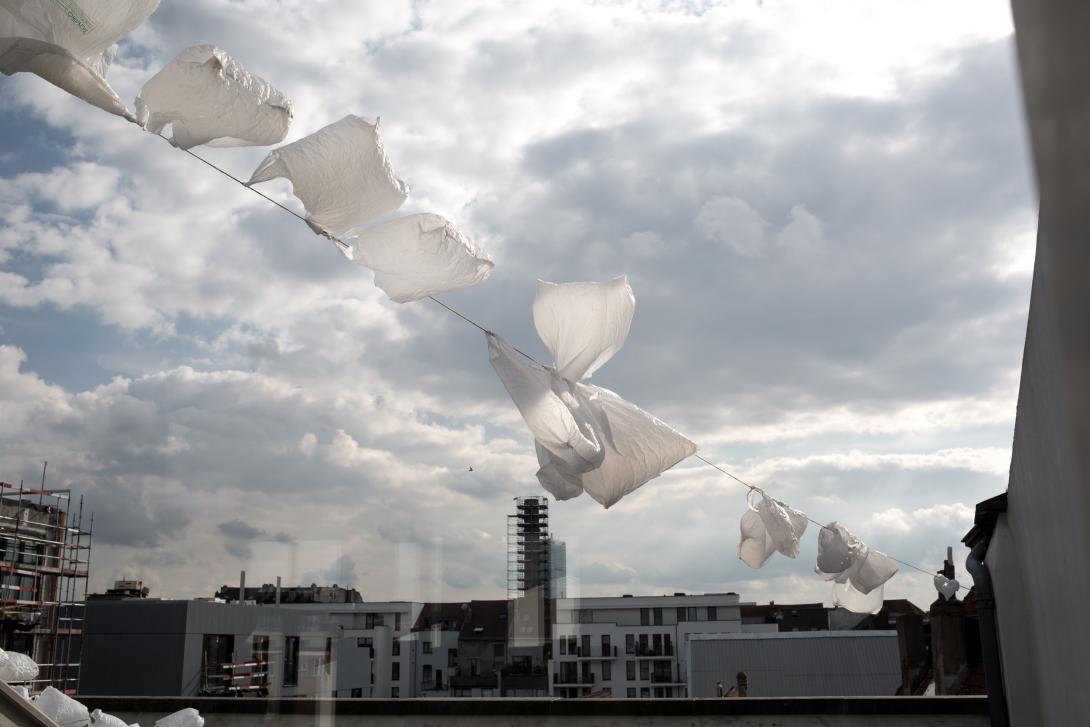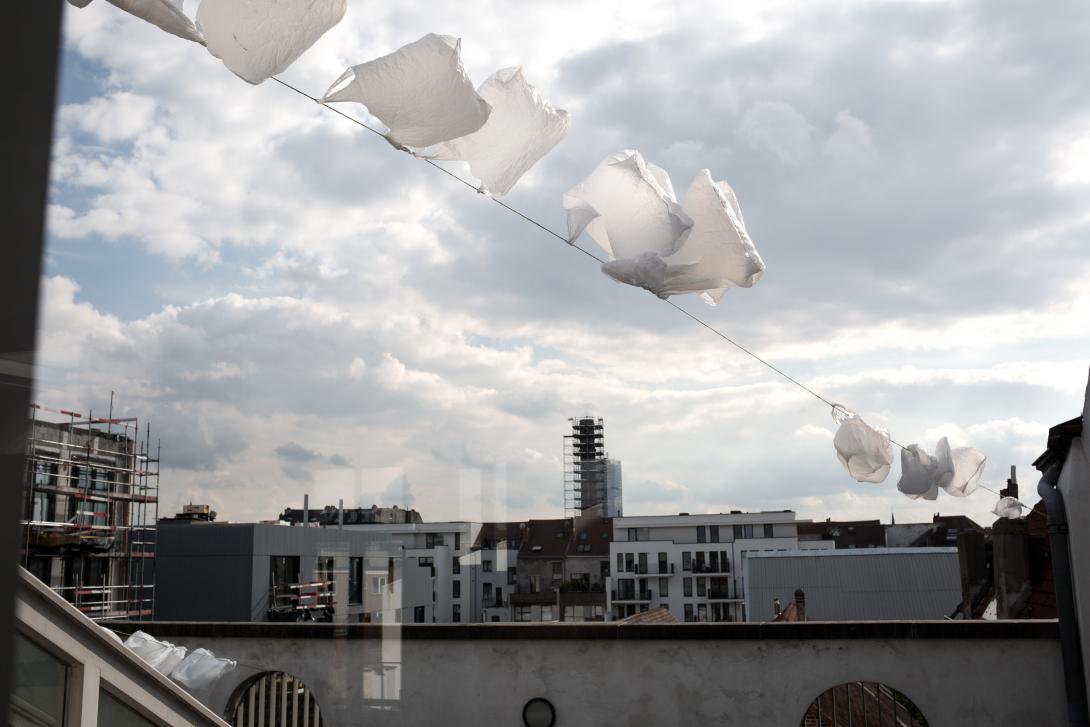The Monastery Escapes The Dictatorship Of Critique
A Conversation with Monk Elke Van Campenhout/Elle
In this ritual-themed season, Kaaitheater is not only welcoming artists. For example, the spiritual urban community The Monastery is coming to the Kaaistudios four times. You are invited to discover the monastic life, for one ritual or for an entire day. But what exactly is the monastic life? Why is a spiritual community coming to a theatre? And what role do rituals and spirituality still play in our society, if any? Time for a profound conversation with monk Elle.
You have had a very varied career, with a background in jazz, philosophy, and performance studies, and as a critic and the founder of the a.pass advanced Master’s and PhD programmes in the arts. How did you become a member of The Monastery?
The Monastery is principally the result of an encounter between two people with the same unusual desire to found a monastery, Stijn Smeets and me. My career as the coordinator of a.pass and as an artistic researcher was originally concerned with different ways of thinking about what the political ‘we’ might mean nowadays. My research – conducted under the title ‘Bureau d’Espoir’ – aimed to explore different ways of creating hope in society, by bringing together very diverse influences without a preconceived plan or guiding ideology.
I was looking for a way to create movement in our social fabric, not so much as the synchronized movement of individuals, but more as a swarm that comes together and constantly reorganizes itself through time. Through this exploration of hope, I discovered a path that diverged from the idea that things can be distinguished between being ‘meaningful’ and ‘valuable’ or not.
My background is in the performance and dance world. What the body is and how it works are important questions in that context. When I started researching spiritual practices that focus on the body, I wanted to know how the technology of the body – how do I breathe, how do I move, how am I physically and energetically linked to the other? – can help to create mental space and movement, in order to generate hope.
Rooted in that idea, I decided simply to accept everything that was presented to me as a spiritual practice for a year. These spiritual practices – and especially Tantra – became increasingly important to me. At the end of my tenure at a.pass, I collaborated with the workspace Bains Connective to organize ‘The Mobile MNSTRY’, a workshop focused on monastic practice in public space, in and around the Abbey of Vorst. This brought the discrepancy between my critical-artistic work at a.pass and my spiritual practice into sharp relief. Incidentally, I met Stijn at The Mobile MNSTRY, and that is where we outlined our first plans for The Monastery.
Wherein do you think the discrepancies between the artistic-intellectual and the spiritual lie?
I started my career as a critic. My work centred around having a critical perspective on contemporary experimental art and artistic research. Making distinctions, highlighting differences, the discourse on power, queerness, gender, who speaks in which way from which position… After ten years at a.pass, that critical approach became more of a restriction than an inspiration.
Since the beginning of the 20th century, art has been in a kind of constant feedback loop, an echo of critique on critique, of self-reflection and undermining. In this critical age, things like beauty, harmony, and originality are far from self-evident. Something always has to counteract them. Although I also chose a spiritual path centred on confrontation, I had the impression that artists were not the only people hindered by the dictatorship of criticism, and that I could no longer grow as a person.
Take the music that we make at The Monastery, for example. It does not comply with certain artistic values and I would never listen to it myself. But it works in the rituals in which we create community together, to make connections and to move into another state of being.
Have you made a radical break with the art world or are there elements that have found their way into your spiritual practice?
I wanted to think of it as a radical break, but I often hear that there are quite a few similarities between The Monastery and a.pass. We both have horizontal organizational structures, trans-spiritualties, queerness of practice, the absence of a leading figure… (laughs) I am still conducting my research into what constitutes a community or a ‘we’. How do you create a community in which possibilities can flourish? It is actually about aesthetics: how do you organize your time and space, and what kind of ethic produces that aesthetic?
Just like the a.pass researchers follow their path, the monks at The Monastery operate based on their own convictions. This differentiates us from a regular monastery. There is no doctrinal truth and content-wise, everything is open: your beliefs can be whatever you want them to be. We share a practice of spiritual routine: of sitting, singing, dancing, and discussing. You notice that a community quickly falls apart when you start debating truths and untruths. I think any spiritual explanation of what ‘it’ is, is problematic. I think it’s fine to skirt around them and set goalposts, but you have to be able to move the goalposts. They are aids, not truths.
You just mentioned that The Monastery is trans-spiritual, but what inspired that? Are there any specific movements or schools that influence you?
We started from our experiences of monastic places. Stijn comes out of a Christian monastic tradition, but clashed with certain church doctrines. My experience was mostly of the Buddhist monastery of the Vietnamese monk Thích Nhất Hạnh in Bordeaux, a mindfulness practice centre. But I had great difficulty with the negation of the body and sexuality. That is how I discovered the tantric path, in which the body is integrated into spirituality. Our practices are a combination of these traditions, but there are also other influences like shamanism or Sufism. Each new resident or monk can also propose new practices.
What is an average day like at The Monastery, and how many monks do you have?
Our day always starts at 6 AM and ends after the evening ceremony around 10 PM, after which everyone is silent until after breakfast the next day. Stijn and I are the only two full-time monks who have taken vows. We currently have three long-term residents who have not taken vows but who do want to live in a spiritual context. We sometimes also have residents who want to come for a short period. Many of them are going through difficult periods in their lives, such as a burn-out or divorce. Their primary focus is on healing.
The monks are absolutely not allowed to miss the morning and evening rituals. In the morning we do body practice, a tea ceremony, sitting meditation, and karma yoga. The evening rituals consist of reading primary sources, reflecting on the day, etc. The long-term residents join us for these rituals.
We also have study and work periods. As a monk, you spend this time in a way that corresponds as much as possible to your monastic practice. Study time means that you train yourself in your specific practice or read texts related to your spirituality. It can be very broad. Work periods are devoted to work for the community. Stijn works with cognitively gifted children and young people at the university in Leuven, which is his service to the community. It isn’t always easy because you have to negotiate the logic of a very different kind of institution. I chose to work exclusively within The Monastery, such as in my Tantra practice and workshops. When I am outside, I work in name of The Monastery.
You have appeared at the Kaaistudios twice before this season, for the seasonal switches, and you are coming back for two more sessions. Why did you accept the Kaaitheater’s invitation?
We talked for a long time about whether returning to an artistic institution would make sense for us. I found it confusing to be confronted with the critical gaze again, which I have let go. Stijn thought of it primarily as a way to give The Monastery more oxygen. And to reach people who might otherwise never consider entering a monastery. I am ultimately very happy with our decision. We worked very hard on the rituals, with new music, texts, and forms. We would otherwise never be able to make so much time to work for The Monastery creatively.
It has also led to interesting situations. For example, Robin is a mindfulness practitioner, with scientific and cognitive interests. I am a Tantra practitioner. How you practice, speak to people, work with imagination, or where you situate your work sometimes makes a world of difference to us. On the surface, we agree on most things, but once you zoom in on the technology of the body, you notice that different practices do actually correspond to different worldviews and anthropologies. That is precisely the challenge that we seek to explore: to what extent can spiritual practice offer a solution to the dualist thinking of good and bad, right and wrong, valuable and worthless. And at what point do judgements sneak in by the backdoor anyway?...
On 9 and 10 March, The Monastery is coming back to the Kaaistudios as part of WoWmen! What can we expect this time?
We are making a combination of the celebration of spring and the queerness of practice. Tantric practices often focus on the polarity of male and female energy, but there is relatively little interest in gender politics or queerness. Interestingly enough, ancient tantric texts never mention the differences between men and women, but focus on energies and ontological powers. Some conservative ideas have thus found their way into Tantra, which I address critically. Incidentally, I do not only deal with this subject in the WoWmen! session: I am also giving a series of workshops on female archetypes at The Monastery’s home base, for women, men, and those who have left such training far behind. In classic tantric practices, this is not easy because you need an equal number of men and women to work as couples. We are happy to break through this gender stereotyping, but it can sometimes be difficult for the participants.



